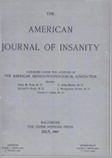THE BLOOD-CEREBROSPINAL FLUID BARRIER IN MENTAL DISORDERS
Abstract
The distribution of calcium between blood and cerebrospinal fluid was investigated in 400 cases of mental disorder. Five hundred and twenty-three determinations of the ratio of blood to spinal fluid calcium were made. In addition, 480 determinations of the distribution ratio of bromide and 347 determinations of the protein content of the cerebrospinal fluid were performed on parts of the same specimens that were used for the calcium determinations.
In the schizophrenic group 29 per cent of the calcium ratios were above 2.2 and 3 per cent were below 1.8. In neurosyphilis 8 per cent of the calcium ratios were above 2.2 and 12.5 per cent were below 1.8. Low ratios occurred with greatest frequency in untreated patients with general paresis. The other groups showed a smaller proportion of abnormal results without any striking preponderance of increased or decreased values.
The results were suggestive of a tendency towards decreased permeability of the blood-cerebrospinal fluid barrier in schizophrenia and increased permeability in untreated patients with general paresis.
There was a general correlation between the distribution ratios of calcium and bromide in schizophrenia, affective psychoses and untreated neurosyphilis. In the individual cases this correlation was frequently lacking.
Low calcium ratios tended to occur in cases presenting increased amounts of protein in the cerebrospinal fluid and high ratios in cases showing decreased amounts of protein, but this relationship was not consistent. A scrutiny of our data clearly indicated that the variations in the distribution ratio of calcium could not be accounted for by alterations in the protein content of the cerebrospinal fluid.
Access content
To read the fulltext, please use one of the options below to sign in or purchase access.- Personal login
- Institutional Login
- Sign in via OpenAthens
- Register for access
-
Please login/register if you wish to pair your device and check access availability.
Not a subscriber?
PsychiatryOnline subscription options offer access to the DSM-5 library, books, journals, CME, and patient resources. This all-in-one virtual library provides psychiatrists and mental health professionals with key resources for diagnosis, treatment, research, and professional development.
Need more help? PsychiatryOnline Customer Service may be reached by emailing [email protected] or by calling 800-368-5777 (in the U.S.) or 703-907-7322 (outside the U.S.).



